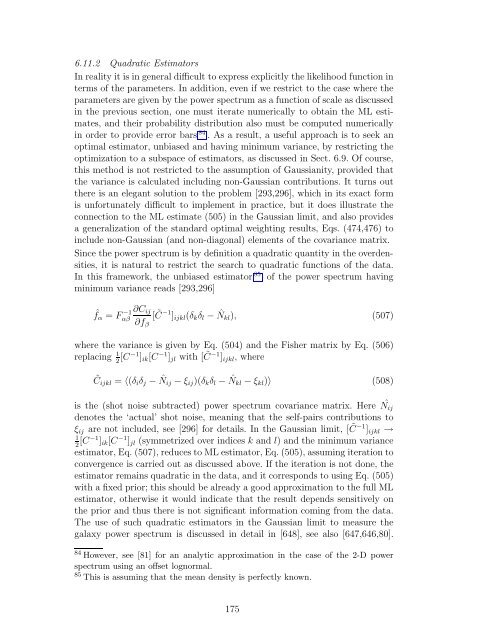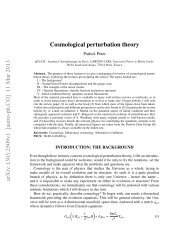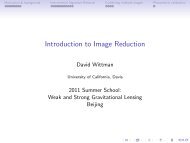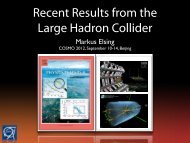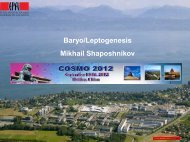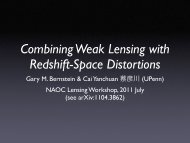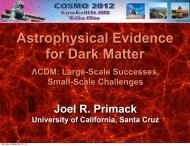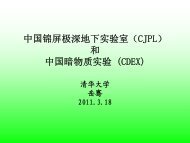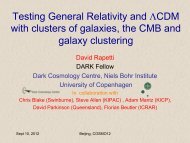Large-Scale Structure of the Universe and Cosmological ...
Large-Scale Structure of the Universe and Cosmological ...
Large-Scale Structure of the Universe and Cosmological ...
You also want an ePaper? Increase the reach of your titles
YUMPU automatically turns print PDFs into web optimized ePapers that Google loves.
6.11.2 Quadratic Estimators<br />
In reality it is in general difficult to express explicitly <strong>the</strong> likelihood function in<br />
terms <strong>of</strong> <strong>the</strong> parameters. In addition, even if we restrict to <strong>the</strong> case where <strong>the</strong><br />
parameters are given by <strong>the</strong> power spectrum as a function <strong>of</strong> scale as discussed<br />
in <strong>the</strong> previous section, one must iterate numerically to obtain <strong>the</strong> ML estimates,<br />
<strong>and</strong> <strong>the</strong>ir probability distribution also must be computed numerically<br />
in order to provide error bars 84 . As a result, a useful approach is to seek an<br />
optimal estimator, unbiased <strong>and</strong> having minimum variance, by restricting <strong>the</strong><br />
optimization to a subspace <strong>of</strong> estimators, as discussed in Sect. 6.9. Of course,<br />
this method is not restricted to <strong>the</strong> assumption <strong>of</strong> Gaussianity, provided that<br />
<strong>the</strong> variance is calculated including non-Gaussian contributions. It turns out<br />
<strong>the</strong>re is an elegant solution to <strong>the</strong> problem [293,296], which in its exact form<br />
is unfortunately difficult to implement in practice, but it does illustrate <strong>the</strong><br />
connection to <strong>the</strong> ML estimate (505) in <strong>the</strong> Gaussian limit, <strong>and</strong> also provides<br />
a generalization <strong>of</strong> <strong>the</strong> st<strong>and</strong>ard optimal weighting results, Eqs. (474,476) to<br />
include non-Gaussian (<strong>and</strong> non-diagonal) elements <strong>of</strong> <strong>the</strong> covariance matrix.<br />
Since <strong>the</strong> power spectrum is by definition a quadratic quantity in <strong>the</strong> overdensities,<br />
it is natural to restrict <strong>the</strong> search to quadratic functions <strong>of</strong> <strong>the</strong> data.<br />
In this framework, <strong>the</strong> unbiased estimator 85 <strong>of</strong> <strong>the</strong> power spectrum having<br />
minimum variance reads [293,296]<br />
ˆfα = F −1<br />
αβ<br />
∂Cij<br />
[ ˜ C −1 ]ijkl(δkδl − ˆ Nkl), (507)<br />
∂fβ<br />
where <strong>the</strong> variance is given by Eq. (504) <strong>and</strong> <strong>the</strong> Fisher matrix by Eq. (506)<br />
replacing 1<br />
2 [C−1 ]ik[C −1 ]jl with [ ˜ C −1 ]ijkl, where<br />
˜Cijkl = 〈(δiδj − ˆ Nij − ξij)(δkδl − ˆ Nkl − ξkl)〉 (508)<br />
is <strong>the</strong> (shot noise subtracted) power spectrum covariance matrix. Here ˆ<br />
Nij<br />
denotes <strong>the</strong> ‘actual’ shot noise, meaning that <strong>the</strong> self-pairs contributions to<br />
ξij are not included, see [296] for details. In <strong>the</strong> Gaussian limit, [ ˜ C −1 ]ijkl →<br />
1<br />
2 [C−1 ]ik[C −1 ]jl (symmetrized over indices k <strong>and</strong> l) <strong>and</strong> <strong>the</strong> minimum variance<br />
estimator, Eq. (507), reduces to ML estimator, Eq. (505), assuming iteration to<br />
convergence is carried out as discussed above. If <strong>the</strong> iteration is not done, <strong>the</strong><br />
estimator remains quadratic in <strong>the</strong> data, <strong>and</strong> it corresponds to using Eq. (505)<br />
with a fixed prior; this should be already a good approximation to <strong>the</strong> full ML<br />
estimator, o<strong>the</strong>rwise it would indicate that <strong>the</strong> result depends sensitively on<br />
<strong>the</strong> prior <strong>and</strong> thus <strong>the</strong>re is not significant information coming from <strong>the</strong> data.<br />
The use <strong>of</strong> such quadratic estimators in <strong>the</strong> Gaussian limit to measure <strong>the</strong><br />
galaxy power spectrum is discussed in detail in [648], see also [647,646,80].<br />
84 However, see [81] for an analytic approximation in <strong>the</strong> case <strong>of</strong> <strong>the</strong> 2-D power<br />
spectrum using an <strong>of</strong>fset lognormal.<br />
85 This is assuming that <strong>the</strong> mean density is perfectly known.<br />
175


